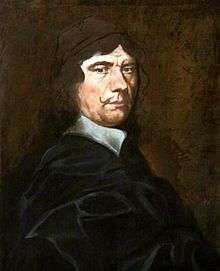Michael Willmann

Michael Leopold Lukas Willmann (27 September 1630 – 26 August 1706) was a German painter. The Baroque artist became known as the "Silesian Rembrandt".
Life


Willmann was born in Königsberg, Duchy of Prussia. He was educated by his father, the painter, Christian Peter Willmann. Michael went to the Dutch Republic in 1650 to learn from the masters, and he was inspired by the works of Rembrandt, Peter Paul Rubens, and Anthony van Dyck. For financial reasons he was unable to afford studying at the studio of a well-known painter.
After two years in the Netherlands, mostly spent in Amsterdam, Willmann returned to Königsberg, passed his master's examination, and began to travel. After visiting Danzig (Gdańsk), Willmann went to Prague, where he stayed from 1653–55. He then spent about a year in Breslau (Wrocław). Willmann's first known paintings, commissioned by Abbot Arnold Freiberger of the Abbatia Lubensis abbey in Leubus, Lower Silesia, date from 1656. Leubus became the setting of much of Willmann's creativity.
From 1657–58 Willmann was in Berlin as the court painter of Frederick William, Elector of Brandenburg. He painted mythological scenes for the elector, presumably for his residence at Königsberg Castle. In 1660 Willmann returned to Leubus, which allowed him a large workshop.
Willmann's workship, modeled after those of the Dutch painters, quickly spread his fame. The extensive studio included his son Michael Leopold Willmann the Younger, his daughter Anna Elisabeth, and Anna Elisabeth's husband Christian Neuenhertz and son Georg Wilhelm Neunhertz. Willmann's studio also counted Johann Kretschmer from Glogau (Głogów), Johann Jacob Eybelwieser from Breslau, the Cistercian Jacob Arlet from Grüssau, and Willmann's stepson Jan Kryštof Liška.
Willmann became the leading painter of Silesia through his expressiveness, technical dexterity, and speed. Willmann worked on orders from the patriciate of Breslau, as well as churches and monasteries throughout Silesia, Bohemia and Moravia. He received contracts for the Cistercian monasteries in Grüssau, Heinrichau, Kamenz, Rauden, and Himmelwitz. With the assistance of his students and assistants, Willmann produced 500 paintings and frescos during his life. Numerous drawings of Willmann's were later used by engravers.
On 26 November 1662 Willmann married Helena Regina Lischka (Liška) from Prague. In May 1663 he converted from Calvinism to Roman Catholicism and took the baptismal names Leopold (after the emperor) and Lukas (after the patron saint of painters). Willmann's prosperity allowed him to acquire a manor near Leubus and sponsor the educations of his son and stepson in Italy. Willmann was detailed in Academia, the 1683 Latin edition of Joachim von Sandrart's Teutsche Academie der edlen Bau-, Bild und Malereikünste. Painters influenced by Willmann include Wenzel Lorenz Reiner, Petr Brandl, Johann Michael Rottmayr, and Franz Anton Maulbertsch.
Willmann died in Leubus, where he was buried in the abbey's crypt alongside the abbots. Because his son died a year later, the studio passed to Willmann's stepson, J. K. Liška, until 1712, and to Willmann's grandson, Georg Wilhelm Neunhertz, until 1724, after which it closed. Willmann's house was destroyed in a fire in 1849.
Literature
- Colmar Grünhagen: Willmann, Michael Lucas Leopold . In: General German Biography (ADB). Volume 43, Duncker & Humblot, Leipzig, 1898, p 301.
- Dehio Manual of the monuments in Poland, Silesia, Munich · Berlin 2005, ISBN 3-422-03109-X.
- Hugo Weczerka (eds.): Handbook of historical sites Silesia . Stuttgart 1977.
- Joachim Bahlcke including: Handbook of historical sites Bohemia and Moravia, Kröner Verlag, Stuttgart 1998, ISBN 3-520-32901-8
- Knaurs art guide Czech Republic, ISBN 3-426-26609-1.
- Hubertus Lossow : Michael Willmann 1630-1706 . Wurzburg, 1994, ISBN 3-87057-179-9.
- Herbert Meinhard Mühlpfordt : Michael Leopold Willmann, in: Konigsberg lives in Rococo. Significant contemporaries of Kant . Writings of JG Herder-winning country library, Volume 7, Siegen 1981, p 84-94.
- Ernst Kloss : Michael Willmann. Life and works of a German Baroque painter, Wroclaw 1934.
- Franz Wagner (Eds.): Michael Willmann (1630-1706), studies of his work . Concept: Rüdiger Klessmann and Bozena Steinborn, catalog for the exhibition in Salzburg and Wroclaw 1994.
- R. Albinus: Königsberg lexicon. Würzburg 2002.
- Detlev Arens: Prague - culture and history of the "Golden City",
External links
| Wikimedia Commons has media related to Michael Willmann. |
- Biography at the Neue Staatsgalerie (German)
- Andrzej Koziel, Rembrandt van Rijn and Michael Willmann, or a story of dispelling a certain myth, in: Rocznik Historii Sztuki, no 33 (2008), p. 153-176
- Literature by and about Michael Willmann in the German National Library catalogue
- http://www.webarchiv-server.de/pin/archiv01/3701ob22.htm
- http://www.kulturwerk-schlesien.de/download/kulturspiegel/KS-JanuarMaerz2005.pdf?fCMS=2a91b1031ad29c38ffc84b6498364089 (PDF-Datei; 585 kB)
- http://www.staatsgalerie.de/aus_willmann/bio.php
- http://www.pinakoteka.zascianek.pl/Willmann/Index.htm
- http://staatsgalerie-stuttgart.de/aus_willmann/sandrart.php
